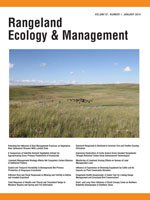Little information is available to help managers of cool-season dominated semiarid rangelands determine when to begin and end grazing in the spring and fall. Therefore, we evaluated the effects of clipping spring and fall growth on subsequent-year yield of needle-and-thread (Hesperostipa comata [Trin. & Rupr.] Barkworth) and threadleaf sedge (Carex filifolia Nutt.) (USDA-NRCS 2012) using a randomized complete block, split-plot experimental design with fall moisture regimes (ambient or supplemental water) applied to main plots and defoliation treatments applied to subplots. Two combinations of spring defoliation, one for each fall moisture regime, were composed of a factorial array of three spring clipping dates (early May, late May, mid-June) and three levels of defoliation (0%, 40%, 80%). A third combination of treatments was composed of the supplemental water regime and an array of a single spring clipping date (late May), a single fall clipping date (late September, after regrowth), and three levels of defoliation (0%, 40%, 80%) in the same year. Ambient fall moisture was low, leading to continued senescence of needle-and-thread and threadleaf sedge, whereas the application of 10 cm of supplemental water in mid-August stimulated fall growth. The study was replicated with two sets of main plots at four sites in consecutive years, 2002 and 2003. Yield data were collected in mid-June of the year following treatment. Subsequent-year yield of needle-and-thread was not affected by defoliation under average plant-year precipitation conditions (2003) (P > 0.05); however, it was reduced following heavy (80%) late spring (late May or June) defoliation during a drought year (2002) (P > 0.05). Subsequent-year yield of threadleaf sedge was not affected by defoliation in either year (P > 0.05). Because it is difficult to predict when drought will occur, avoiding heavy late-spring grazing in needle-and-thread–dominated pastures in consecutive years would be prudent.
How to translate text using browser tools
1 January 2014
Yield Response of Needle-and-Thread and Threadleaf Sedge to Moisture Regime and Spring and Fall Defoliation
Ann E. Koehler,
W. Douglas Whisenhunt,
Jerry D. Volesky,
Patrick E. Reece,
Thomas L. Holman,
Lowell E. Moser
ACCESS THE FULL ARTICLE
Carex filifolia
drought
fall regrowth
Hesperostipa comata
Stipa comata





